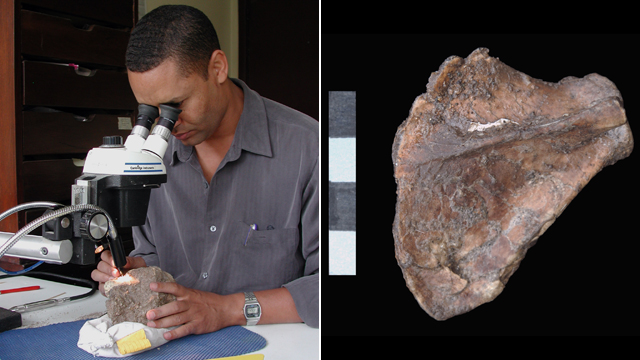
With the holidays just around the corner, this is a time when many of us ponder what it means to be a better person—helping others in need, etc. But what does it mean to be a person? This provocative question is at the root of a discovery just announced on the cover of Science by Bay Area scientist Zeray Alemseged, Curator of Anthropology at the California Academy of Sciences and Midwestern University Professor David Green.
Australopithecus afarensis (the species of the well-known “Lucy” skeleton) was an upright walking species, but the question of whether it also spent much of its time in trees has been hotly debated for 30+ years, partly because a complete set of A. afarensis shoulder blades has never before been available for study. In an extensive analysis of two complete shoulder blades from the fossil “Selam”—the only ones from this pivotal species known to science—Alemseged and Green found the bones to be quite apelike, suggesting that our forebears were still climbing trees as bipedalism was emerging.
Selam was a three-year-old A. afarensis girl who lived about 3.3 million years ago. Alemseged discovered her in Dikika, Ethiopia in 2000, and she represents the most complete skeleton of her kind to date. It took 11 years to carefully extract Selam’s paper-thin shoulder blades from the rest of the skeleton, which was encased in a sandstone block. Shoulder blades are so delicate that they rarely fossilize, so when they do, Alemseged notes, they are almost always fragmentary, underscoring the tremendous value of these particular bones. Once the bones were free, the team digitized and took detailed measurements of them to characterize their shape and function.
On the evolutionary path to “human-hood,” the emergence of bipedal locomotion (walking upright) and the abandonment of arboreal behavior (when we stopped hanging out in trees) are widely accepted as major milestones. But anthropologists have become sharply divided on whether the presence of ape-like characteristics in australopith species are evidence that tree-climbing was still important part of life or merely leftover traces of a feature no longer needed (like a vestigial tail).
Alemseged and Green looked at how young Selam’s shoulder blades compared to the shoulder blades of her mature A. afarensis counterparts: other human ancestors like Homo ergaster (“Turkana Boy”); Homo floresiensis (“The Hobbit”); A. africanus; and modern humans and apes. They found the pattern of growth in A. afarensis was more consistent with that of apes than humans. At the same time, most researchers agree that many traits of the A. afarensis hip bone, lower limb, and foot are unequivocally humanlike and adapted for upright walking. So were they walking or swinging?